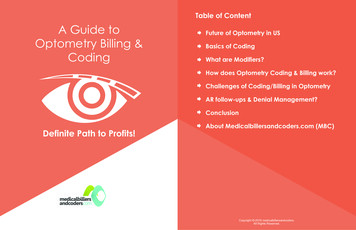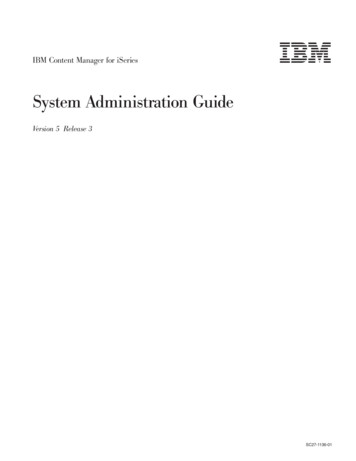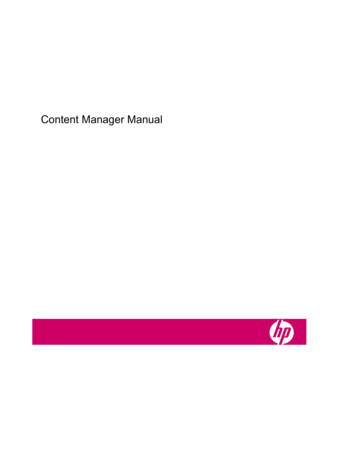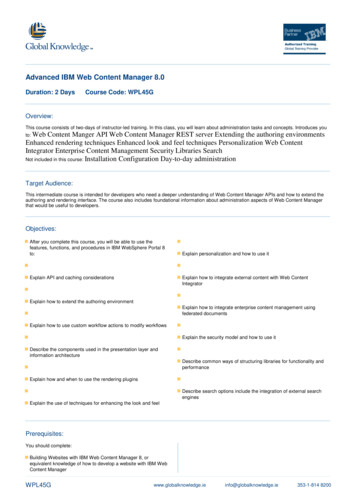
Transcription
Table of ContentA Guide toOptometry Billing &CodingFuture of Optometry in USBasics of CodingWhat are Modifiers?How does Optometry Coding & Billing work?Challenges of Coding/Billing in OptometryAR follow-ups & Denial Management?ConclusionAbout Medicalbillersandcoders.com (MBC)Definite Path to Profits!Copyright -2016 medicalbillersandcoders.All Rights Reserved.
Future of Optometry in US:22.3%The field of optometry is growing & changing at a rapid pace.As per 2013-2014 Association of Schools & Colleges ofOptometry (ASCO) Annual Student Data Report, following aresome of the major changes that are happening in theoptometry student population:Number of full timeoptometrystudents over thepast five years2013-2014 sawstudents coming infrom every state in theU.S.The study further projected increase in patients with Type 2diabetes by 2025 is around 12 percent of the U.S. population,coverage expansion due to ACA (which includes 25 millionadult Americans by 2017-18), and the pediatric essential benefit(which is additional 8.4 million newly covered children). So by2025, these factors create an undersupply of eye carepractitioners to 9,400 FTE.A significant reason of that increase in demand is alsoexpected to be from the inclusion of optometry as part of thedelivery of full-scope medical care. This demand tied to healthreform and optometry's growing role in multidisciplinary care ofmedical conditions (such as diabetes or glaucoma) clearlyshows that optometry has a chance to expand into a growingmarket.The aging population with vision problems like cataract,macular degeneration and glaucoma and increasedincidences of hypertension and diabetes will generategreater demand for optometric services as these diseasesoften affect eyesight.Full time Asianstudentsincreased to2.6%With the changing scope of optometry and its integration intothe mainstream health care, the need of the hour is to evaluatethe existing optometric workforce. A study was conductedwhich projected the supply of total eye care providers (bothoptometrists and ophthalmologists) through 2025. This baselinedata indicated a shortage of approximately 4,300 FTE (full-timeequivalent) eye care providers over the next decade.The popularity of laser surgeries to correct the existing visionproblems will require ongoing preoperative andpostoperative care for laser surgery patients.As per American Optometric Association, around onequarter of currently practicing optometrists areapproaching their retirement age. And as they retire, manyindividual as well as group practices opportunities will arise.Also, optometric assistants and other support personnelemployment will increase so that the time an optometristneeds with each patient reduce.
Basics of Coding:In an Optometric practice, there are around 16 ways in whichthe eye examinations can be coded. This does not include theconsultation visits. So understanding the codes and theirdefinitions is the core of coding and billing. In ophthalmicpractice, the standard code sets consist of ICD-9 codes fordiagnoses, CPT codes for procedures and HCPCS (Health CareProcedural Coding System) codes for procedures not coveredunder the CPT umbrella.Although, most carriers have policies that follow CPT but theymay have some specific guidelines and policies build on theCPT definition for a particular code. So, it’s important to be sureof a carrier’s specific policies related to billing a code ratherthan relying on the CPT definitions. These policies are referred toas LCDs (Local Coverage Determinations) and are readilyavailable on the carrier’s website. These LCDs or LMRPs (LocalMedical Review Policies) as referred in older language, definethe appropriate guidelines for using a particular code.Very often while coding eye examinations, practitioners use the920XX codes, since the documentation requirements for thesame are much easier to meet. Though these codes are best touse for general examination, one still needs to use E/M codes forservices that are out of the box & do not fit under the umbrella ofthe eye codes. The CPT has recognized that while detailing allthe components of an examination, Ophthalmic codes work ona different principle from E/M codes:"Intermediate & comprehensive ophthalmological servicesconstitute integrated services in which medical decisionmaking cannot be separated from the examining techniquesused. Itemization of service components, such as slit lampexamination, keratometry, routine ophthalmoscopy,retinoscopy, tonometry or motor evaluation is not applicable."For both New (a patient who has not received any professionalservice from a physician of the same specialty for last threeyears) and established patients, eye code visits are eithercomprehensive or intermediate.Most common 920XX codes used for ‘Medical examination &evaluation with initiation of diagnostic treatment program’ for:The essential 16 codes for coding eye examinations in anoptometric practice are:4 Ophthalmic visit codes (920XX),10 evaluation and management (E/M) codes(992XX) and92002 (Ophthalmological Services): New Patient,Intermediate.92004 (Ophthalmological Services): New Patient, one ormore visits, Comprehensive.92012 (Ophthalmological Services): Established Patient,Intermediate.2 HCPCS "S" codes (S062X).92014 (Ophthalmological Services): Established patient, oneor more visits, Comprehensive
The exception CPT 92015 Refraction is not a part of before mentioned codes.VISIT CODESCodes (92004, 92014) as general evaluation of the complete visualsystem". . . includes history, general medical observation, externaland ophthalmoscopic examinations, gross visual fields andbasic sensorimotor examination. It often includes, asindicated: biomicroscopy, examination with cycloplegia ormydriasis and tonometry. It always includes initiation ofdiagnostic and treatment programs."Comprehensive Eye Examination,The CPT code states “one or more visits” required for anexamination i.e. a single service that could not beperformed in one session. For example, when a patient declines dilation inthe first visit and comes at another time to complete the dilated portion of the exam.In such cases, the claim & the respective medical recordshould reflect that the examination took more than onevisit.Intermediate Eye ExamCodes (92002, 92012) as defined by CPT:Some practitioners down code a service provided, byusing intermediate codes to reduce the cost of an eyeexamination to a non-insured patient & fill over paymentclaims for insured patients which is unethical.Many carriers have become aware of such billing patternsand they take effective measures to curb such practices.E/M CODESThese codes are typically used for patients who come witha medical complaint or a continuation of medical casemanagement (i.e., glaucoma, allergy, dry eye).The complexity of their application is high and require morethan one page of documentation for a comprehensiveexamination with more specific requirements related tocase history, medical decision made and elements ofexamination used are documented.S CODESThese "S" codes are a subset of the HCPCS codes.The CPT codes are usually known as the ‘Level One’ codes.Codes which are used by providers for coding proceduresthat are either inadequately defined by CPT or there is noformal CPT code existent are known as ‘Level Two’ codes.These are basically used for describing internal coding butthird-party insurance carriers do not accept or recognizeall of these ‘Level Two’ HCPCS codes.For coding an eye exam, Optometry's training is generallylimited to the information that the visioninsurance/refractive insurance plans provide. But twothings are known for sure:The 920XX codes are not for routine patientsRefraction is not a part of 920XX examination codes.
What are Modifiers?How does Optometry Coding & Billing work?Modifiers are abbreviations that help describe the service andget paid properly. There are around 17 modifiers:Optometry Coding is the standardized numeric and alphanumeric systems used to identify specific procedures and servicesperformed. eg: An optometrist no longer does refraction, he performs a 92015(determination of refractive state) and he no longer takes photos, he performs 92250-E1Left Upper Lid-E2Left Lower Lid-E3Right Upper Lid-E4Right Lower Lid-LTLeft Eye-RTRight Eye-GYNon-covered service under Medicare-TCTechnical Component (eg. performing visual field or OCT for another doctor to interpret)-24Unrelated service performed by the same physician during a postoperative period-25Significant, separately identifiable exam service performed by thesame physician on the day of a procedure or other service(photography with interpretation and report). Billingrefers to the submission ofthese codes on a claim for reimbursement billed by the payer tothe subsequent provider.Claims are prepared by listing codes that report the patient’scondition and the diagnosis and procedure performed.As per the Medicare Claim processing Manual, there are a set ofrules for reporting diagnosis codes on your patient’s claims.Use code that accurately describes symptoms & diagnosis,Use the code that is responsible for the services providedCode a chronic condition as often as possible-26Professional component only(for example: you do the interpretation and reporting of a visual fieldperformed by someone else)-50Bilateral Procedure-51Multiple procedures during same session-52Reduced Service-54Surgical Component onlyAssign codes with the highest level of specificityCode all documented conditions at the time of visitIn some plans, the reason for visit determines the coding.Beware of discrimination:(the surgeon can append this code, if you are performing in the postoperative period)-55Post Operative Management only-79procedure by the same physician during the post-operative period(used for post operative care with surgeries)There should be one fee schedule for each CPT code. Multiple feeschedules are biased and may lead to reduced reimbursements,if they analyze a pattern of discount in your claims. A worst casescenario could be that you have been discriminate and abusivein your billing patterns and may demand monetary damages.
9 Challenges of Coding & Billing in OptometryDuplicateClaimsBilling fornon-coveredservicesMedicalNecessityLack ofawarenessof NCCIEditsMedicareEligibility ofBeneficiaryMedicare isa secondarypayerPrimarydiagnosiswas notcoveredMedicalinsurancevs. VisioninsuranceInvalid orIncompletemodifierusageCoding & billing practices have changed a lot either because of unawareness of new regulations or because of complexity of codes& claim procedure. But a clear understanding of these common coding & billing errors is important to overcome such challenges.Duplicate:Claims get denied on account of being duplicate. Eitherclaim is re-filed it as the payment was not made in 30 daysor the initial claim was processed with no payment.In such cases, the second claim is considered duplicateand it’s better to call Provider Services to verify the claimprocessing status before re-filing the claim.Billing for non-covered services:A long list of Medicare exclusions exist like eye exams forprescribing, fitting or changing eyeglasses or contactlenses in the absence of disease or injury to the eye.It is important to stay up-to date on the current exclusionpolicies either by checking with your Medicare carrier orby directly visiting Medicare’s website.Medical Necessity:A lot of claims are denied on the basis that the payerdoes not think the procedure done for the diagnosis was a‘medical necessity’.Here, the medical records should show the preciseness ofthe tests conducted in form of photos anterior & posteriorsegment) that help in providing higher level of care.Lack of awareness of National Correct Coding Initiative Edits:A review of which codes can/cannot be billed togetheron the same date of service will help in fewer denials.You may access the NCCI Edits on the Medicare Web site& familiarize yourself with the appropriate code status of aspecific CPT code. These may change on quarterly basis.
Medicare Eligibility of Beneficiary:Claims are denied due to an invalid Medicare number dueto- Non eligibility ofbeneficiary to receive medical benefits or claim filing to be done to anotherinsurance plan.Screen the Medicare number of thepatient & check for effective date &status.Medicare is a secondary payer:Applicant is 60 years & covered under Employer’s Group health Plan (EGHP)Cases of work related injuries included under workers compensation plan.Where primary filing should be under medical, Personal Injury Protection (PIP),workers compensation, auto, no-fault or policy including self insurance plans.Obtain detailed information relatedto status of the Medicare patient oneach visit and contact your ServiceProvider about potential conflictsthat may arise and the appropriatecoordination of benefits.Invalid or Incomplete modifier usage:Claims are denied because themodifier that is needed to processthe claim is either missing,incomplete or invalid.Know the proper use of CPT modifiers to be used for specific conditionsMisuse of modifiers is under the scrutiny of the Office of Inspector General & mayresult in significant penalties.Primary diagnosis was not covered:Claims could be denied becausethe primary diagnosis mentionedwas not performed.Familiarize with the policies for medical necessity & related documentationTake caution in using any automated software that provides covered diagnosis.Medical insurance vs. Vision insurance:Medical insurance rather thanvision insurance is common.Reimbursement in former arehigher than latter.Before billing read through vision plan contracts. Some may clearly state that thecontracting doctor can only collect vision plan co-pay even though the medicalservices are rendered.Understand medical billing rules which are different from vision plan billing rules
Account Receivables (AR) follow-ups andDenial Management:Insurance Billing will always entail an outstanding AR, the skill is tokeep it within 30 to maximum 90 days bracket. Here, is when the ARfollow-up team comes into picture. The AR team:Is responsible for follow-up with the insurance companyManages the denial from insurance companies and works ontheir resolution.Analyzes the denied claims, partial payments and nonpayments.Communicates with the patient, insurance company and thehospital/nursing homeWill outsourcing AR and Denial Management functions to medicalbilling companies beneficial?Earlier, AR management used to be a departmental activity. Theeffectiveness of the AR team no doubt will directly impact thefinancial health of hospitals, doctors and nursing homes.Outsourcing your AR and Denial Management functions to amedical billing company will not only increase your medicalreimbursements, but will also maximize the effectiveness ofcollecting unpaid claims.Medical billing companies have an expertise that handles the RCMfor hospitals, nursing homes & doctors. They:Access the AR data through client’s EMR/billing system foranalysis and reviewTake care of the critical functions involved in AR managementlike filing of appeals, updating insurance contracts, assessinginsurance low pays, managing unapplied balances andrefunds, processing patient statements & delinquency letters.Sort the AR into buckets like current, 30-45 days, 45-60 days andabove 60 days (working on critical claims first)Call the third party payers and insurance companies to checkclaim status, re-file or for gathering additional informationDocument and analyze the call outcomes to study AR trendslike consistently low payments & reason for frequent denialsMake reports on parameters such as:Status of each claimPayment receivedAdjustments/ Write-offsAR aging reportOutstanding and Trend AnalysisThe experts are well trained and experienced in denialmanagement.
Last thoughts on Optometry BillingAbout MBC (Medicalbillersandcoders.com)Coding for the optometric services has become seeminglycomplex, but keeping up with the latest policies and guidelines willensure fewer coding and billing errors with a much higherprobability of reimbursements resulting in greater profitability.MBC is the largest consortium in the US offering physicianscustomized solutions to all their billing related problems. Ourtechnology and expertise caters to the exact needs of thephysicians’ billing requirement.While generating the claims ensure that the primary diagnosissupports the CPT code.A claims management system should be an important andintegral part of your practice management system.If your practice management system has built in ICD codes,ensure that there are some error-checking features to checkthe accuracy of the claims.As an O.D., your practice should ensure that insurance billing isperformed daily or at least weekly and not later than that.Your front desk staff should check a patient’s insuranceeligibility and authorization from your practice managementsystem before booking an appointment or proceeding to theexamination room.]If there are any glitches, you should explain the detailedcharges to the patient. If their plan has a co-pay element,ensure that the payment is collected in full at the time of theservice and not delayed.As the scope of Optometry has gone on to be extensive, its billingcycle management too has become an intense exercise. Providerswho could easily manage in-house billing, now find it prudent to getit done by an outside agency that ensures cost minimization andrevenue optimization, and enable them to focus on quality care.Having evolved with billing challenges, our billing experts canextend their result-oriented services to the entire gamut ofOptometry medical billing including prescription and fitting lenses toimprove vision, diagnosis and treatment of eye disease and amultitude of laser surgical procedures.Our medical billing management cycle results in:Simplified revenue cycle with enahnced collection ratesMore patient inflow and referrals, andIncreased avenue for medical research and development4625 Morse RD., Suite 208, Gahanna, Ohio 43230info@medicalbillersandcoders.comFax: 888-316-4566Toll Free: 888-357-3226Copyright -2016 medicalbillersandcoders.All Rights Reserved.
These are basically used for describing internal coding but third-party insurance carriers do not accept or recognize all of these 'Level Two' HCPCS codes. For coding an eye exam, Optometry's training is generally limited to the information that the vision insurance/refractive insurance plans provide. But two things are known for sure:











